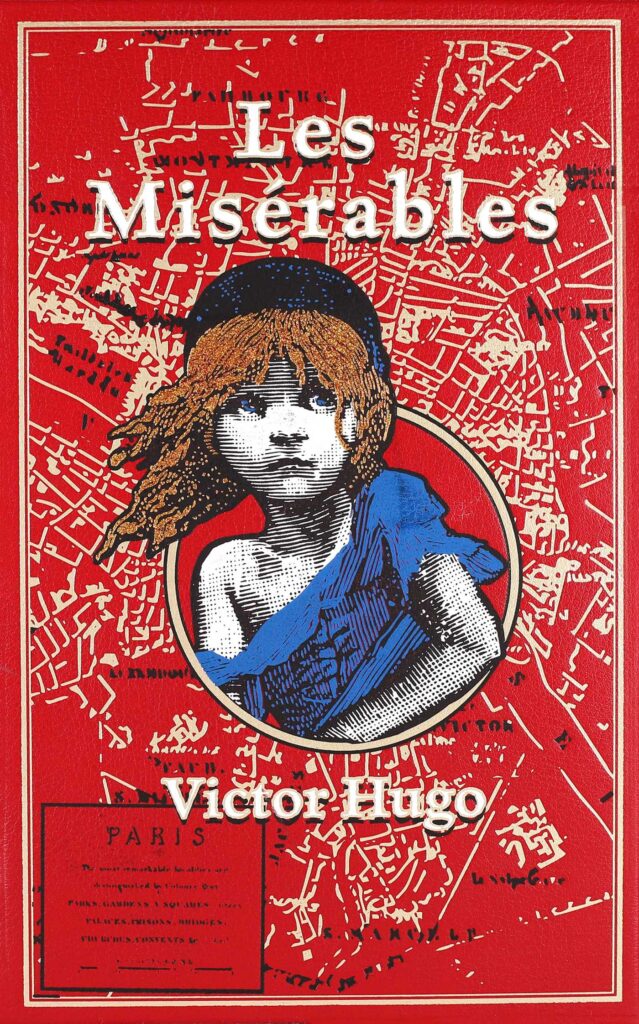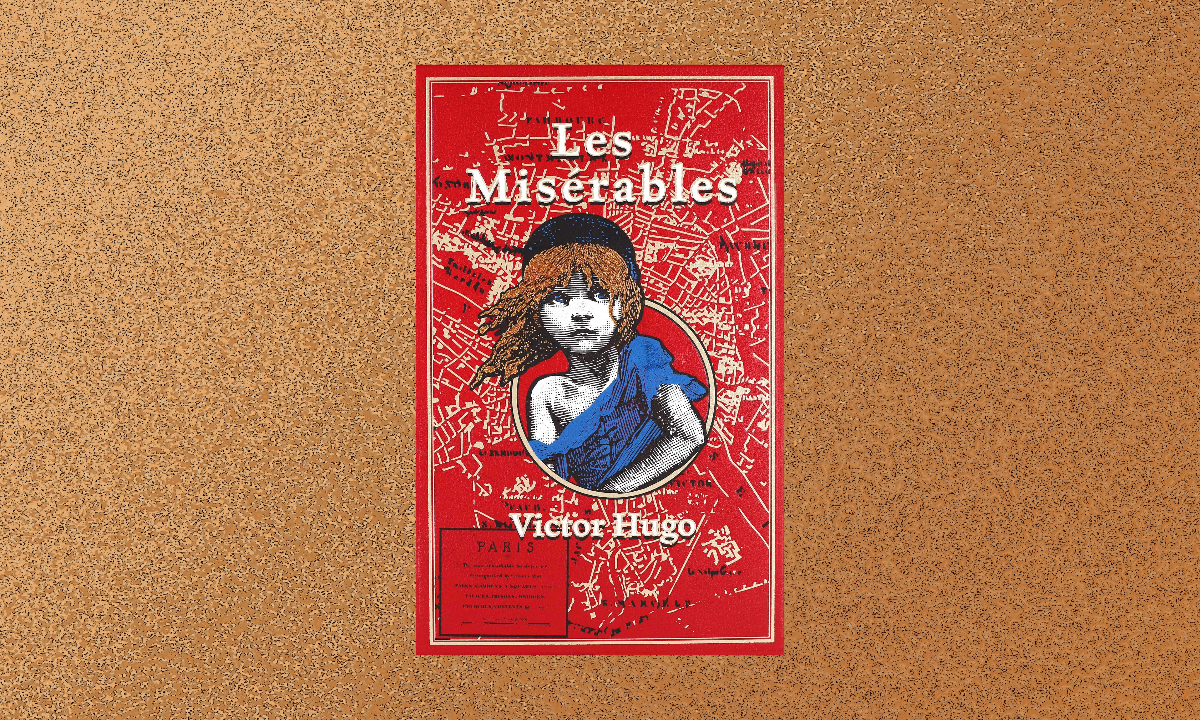In Les Misérables, the beginning isn’t the beginning. It’s a digression from a digression. In this review, the author considers the ideas generated by the novel, which are, otherwise, difficult to narrow down into specific themes.
Victor Hugo’s Les Misérables, affectionately called The Brick by fans, was first published in 1862. Widely considered to be one of the greatest novels of the 19th century, this juggernaut of a book looms heavily over the French literary scene. Written while in political exile for his criticism of Louis-Napoleon and published in Brussels to escape French censorship, Les Misérables was a highly anticipated work and released simultaneously in several European cities, making it one of the biggest international book launches of its time. Victor Hugo had succeeded Goethe as the arbiter of Europe’s literary and moral conscience.
That the book survived to see its completion and publication itself is nothing short of miraculous. Hugo started working on the book in 1845. Rioters almost destroyed the manuscript in the political unrest of the following years. Similarly, the publication and circulation of such a gigantic book and in such great numbers was contingent on certain technological inventions. The recent arrival of steam-powered steel presses and the availability of inexpensive paper made such a circuit of distribution possible. It was a commercial success and caused moral and legal ripples in French society, spawning endless numbers of adaptations, including films, musicals, video games, animes and mangas.
Prmise of the novel Les Misérables
Jean Valjean, an impoverished young man, is jailed for five years for stealing a loaf of bread for his starving family. His countless attempts to escape slowly increased his jail time and is finally released on parole after 19 years. While in the city of Digne, bitter and angry after having been turned away from several houses on account of his past as a convict, Valjean is finally given shelter by Bishop Myriel. At night, Valjean steals the Bishop’s silver and escapes but is promptly caught by the police.
The Bishop lies to the police that he has indeed given Valjean the silver and presses two more candlesticks into his hands as if he had forgotten to take them. The Bishop says to Valjean that his soul has been bought for God and that he should use the silver to make an honest man out of himself. Here begins the story proper, although this summary leaves out much of Hugo’s philosophical, religious, and political digressions, which are some of the best parts of the book. From here, the plot is deceptively simple: Valjean, determined to leave behind his criminal past, tears up his parole documents and begins a journey of reform and social upliftment.
A regular cast of characters begins to form: Javert, a relentless policeman who runs into Valjean through a series of coincidences and is determined to bring him to justice; Fantine, a working-class woman pushed into poverty and eventually sex work; Cosette, her illegitimate daughter whom Valjean adopts; the inn-keeper couple, the Thénardiers, and their children, Éponine and Gavroche; and finally, Marius, the brooding, politically confused young man who is deeply in love with Cosette. All these storylines coincide and culminate in the 1832 June Rebellion in Paris.
A Tragedy with Notes on the Infinite

Les Misérables is about the triumph of the defeated and the dirty. Only from the profane is the sacred revealed. Progress is turning shit into gold, profanity into poetry. His characters are the neglected children of humanity (read: of Paris). For Hugo, however, there is little difference between his city-muse and the rest of the world.
At the level of the plot and characters, there are individual failures–sons fail to recognise their fathers; convicts escape recognition by way of funny wigs. But society as a whole fails to recognise struggle, survival and pain. It fails to recognise argot (the creative conlang used in the underbelly of Paris). It fails to recognise those that slip past census and statistics. Two sections come to mind: the sections on argot and the sewers. These are perhaps the two digressions that are mocked the most–translator, Norman Denny, in his efforts to streamline the book, relegated the section on argot to the appendices.
In Hugo’s description, argot is disguised speech used by criminals to hide their intentions from those too interested. It is a work of astounding creativity performed by a kind of social consensus. Argot is the ever-evolving wordplay that contorts and changes in its efforts to escape the law’s notice. It’s a labyrinth of puns, slang, and idioms. If the human spirit can (in the face of hunger and dire necessity) give birth to such creativity, imagine what heights it could achieve if nurtured and cared for.
Related to Paris: Explore the World: A Literary Tour Through Paris in 10 Books
Progress from the Profane
This brings us to the sewers and Hugo’s idea of progress. It surprisingly involves a call for environmental activism as a form of social justice. When first described, the sewers were dirty and poorly maintained, spreading disease and harbouring the criminals and the desperate. The sewers are, he says, “the conscience of the city.” i.e., there is honesty in filth. This is a repeated motif in Les Misérables: dirt and despair reveal some kernel of the soul’s truth. However, by his time, the sewers of Paris had been transmuted. Now, they have been remade, cleaned, corrected and functioning meticulously.
Yet, there is more to be found in waste. For example, human waste can be repurposed as fertilisers. So, progress is transmutation, like a contraption that carries filth (but filth itself has worth if only someone noticed). Hugo’s dream of such progress is embodied in the urchin Gavroche – a silly, ridiculous, contagiously brave little boy who is too quick for the world but is always ready to catch whoever falls through the cracks and to carry them towards the horizon of this stupid world that is better off for having them in it.
All his characters dream of a vibrant, unlimited future. Some succeed for others, if not for themselves; most fall victim to fate – either killed or killing themselves. Some that survive abandon their morality. For others, their morals are a chain around their necks. Yet, for each and every one of them, the weight of society is bearing down on their shoulders. Cruelty is the easiest way out for some.
Are we Made for Purpose or With Love?
Finally, we come to Hugo’s ponderings on justice and judgement, redemption and righteousness, law, mercy and grace. That is to say, all things that shape the human spirit, either to contain and restrict or to liberate and make sublime. It is by the strength of their belief in these things that the human spirit evolves. In some cases, it stagnates into bigotry and blindness to and denial of reality. But the clear absence of these confines one to a small, mean, vicious existence. There are only a handful of characters whom the reader and Hugo both find unforgivable–the dissolute bourgeois Félix Tholomyès, Fantine’s lover and Cosette’s father, who abandons Fantine after a few years of youthful amusement and goes on to become a lawyer. The other being the morally wretched Thénardiers.
A Note on the Many Translations
Choosing a translation is a matter of personal taste. Of the major English translations of Les Misérables, some are abridged, and each has its own distinct tone. Earlier translations like that of Charles Wilbour (1862) and Isabel Hapgood (1886) tend to stick closer to Hugo’s text while also using prominent literary styles of 19th-century English literature.
Of the more recent attempts, Norman Denny’s translation is somewhat abridged for purposes of readability. He glosses over details, footnotes, and endnotes. He also moved two of the digressions to the appendices. He, however, has a grasp on the moving poetry of Hugo’s language, which shines through in his translations. Julie Rose’s 2008 translation is perhaps the most dissonantly modern and, thereby, the easiest to read.
Veering far from the frequently used manners of expression, Rose’s translation is livelier, uses English slang and can often be jarring. The best of the lot is also the most recent, Christine Donougher’s 2013 translation, which modernises the language while maintaining the simplicity and wit of the original text. Donougher ignores none of Hugo’s original rambles: from the botanical debates to the schools of thought of the day, her text preserves the style and vocabulary while remaining accessible to modern readers.
A Note on the Adaptations
Les Misérables has been an inspiration for many adaptations on the stage and the screen. The sheer size poses the first challenge. Each adaptation is deeply flawed on its own because they attempts to hack out a three-act narrative from this great, shaggy book. The most famous is perhaps the three-hour, love-it-or-hate-it musical phenomenon by Claude-Michel Schönberg and Alain Boublil, which became the longest-running musical in the West End.
The most accurate in spirit, perhaps, is Ladj Ly’s 2019 crime drama of the same name, which has not so much of a plot as much as a setting where lives unfold. His first major feature film, Les Misérables, depicts the everyday misery of the inhabitants of a working-class suburb. Set in Montfermeil after France has won the 2018 World Cup, the film follows a group of young black teenagers and an anti-street crime police unit as they navigate ethnic clashes and police brutality. Ly’s film is exceptionally well-made, mixing drone shots with a handheld camera to switch from the scenic to the chaotic to show a crumbling, decaying Paris suburb where lives are snuffed out, whether by systemic abuse or cultural conflict.
Also Read: Timeless Tales: 20 English Classics to Enrich Your Literary Journey
Why You Should Read Les Misérables
Les Misérables’ legacy extends beyond just the literary. The book had a considerable impact on French society. It proposed several policy changes that French governments have since adopted over the last 150 years. These included the abolition of the prison passport that perpetually marked one out as a convict, recognising crimes of necessity, creating more employment for the uneducated, and making elementary education universal, obligatory and affordable.
Much maligned for its length, strange schlocky coincidences to further the plot–although Hugo would call them providence–that wouldn’t be out of place in an Indian soap opera, nothing of humanity is ignored for want of space and time in the book. Thus, the loquacious narrator pauses and ponders everything. Once the necessity of the book’s length is clear, it becomes a joy to follow Hugo’s constant pursuit and perusal of every little thing that catches his fancy. Every useless trivia is brought vibrantly, vividly alive. This is the world Hugo dreams of and constructs in Les Misérables, which becomes a collage of the world in general. What preoccupies him, sadly, are battles we are still fighting today. Hugo cares deeply about women, the poor, the incarcerated, and the proletariat. He is keenly aware that society is inflicted upon some people rather than them inhabiting it. It demands more from some while giving back less in return.
If you are looking for a book that will break your heart, stir your anger, and shape your idealism, this is the book for you. Les Misérables is a testimony to the endless possibilities of human kindness. It will force readers to reconsider their faith in systems of oppression. You will come out the other end, moved beyond misery into anger and action.
Related to translated work: Literary Regional Gems: 10 Must-Read English Translations from Different States of India

